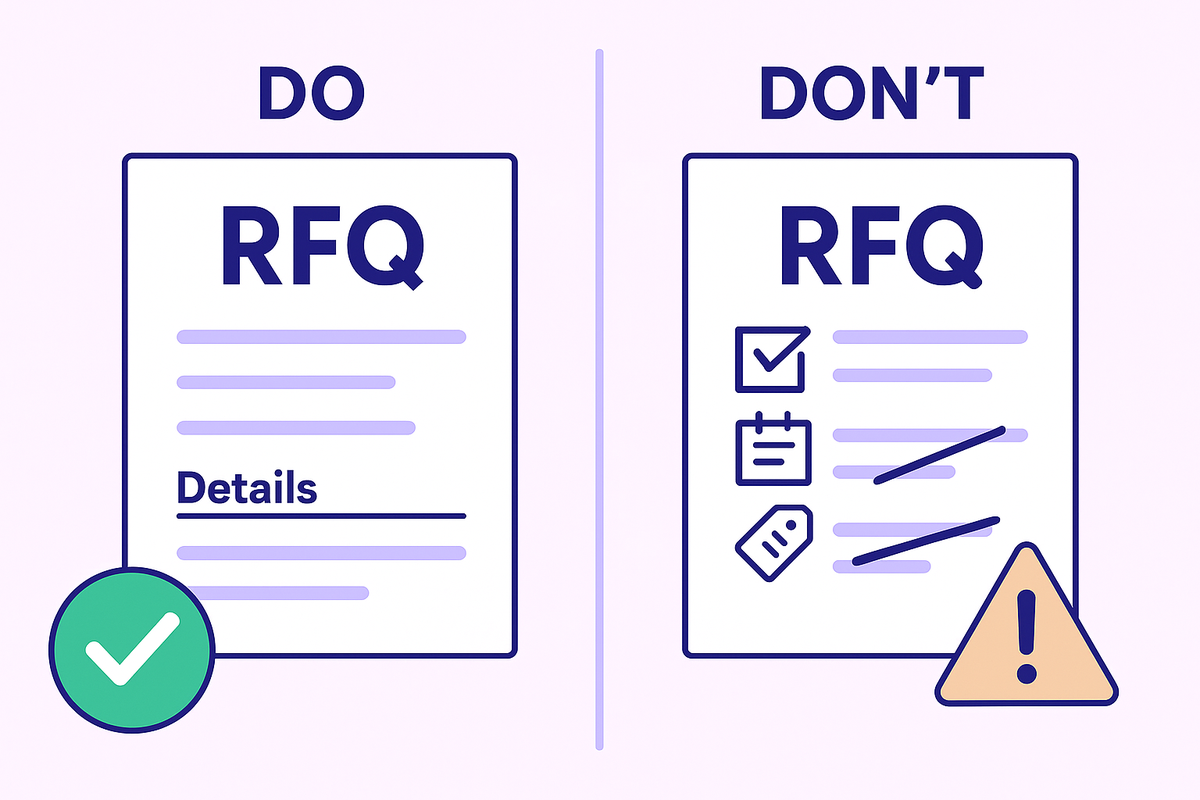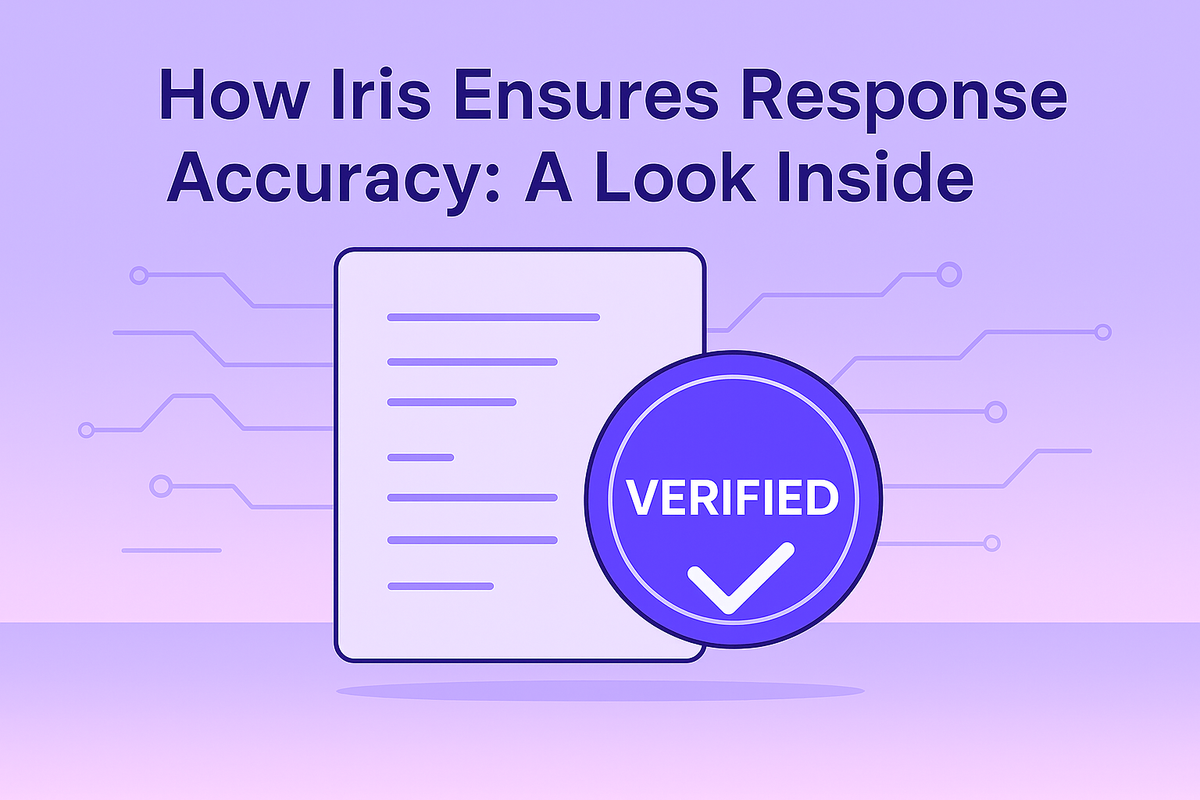The Complete RFQ Process in 6 Simple Steps
August 4, 2025
By
Evie Secilmis

A Request for Quote (RFQ) should make buying easier, but vague requests often create chaos. You end up with a stack of quotes you can't compare—one vendor misses a key spec, another quotes a different model entirely. These common RFP response mistakes are often rooted in the initial request, leading to a flawed supplier evaluation. When sourcing complex machinery, clarity is everything. Knowing exactly what to include in an RFQ for industrial equipment is the difference between a smart purchase and a costly error. We'll explore these common pitfalls and provide insights into how you can avoid them.
When a Request for Quotation (RFQ) lands in your inbox, it’s usually a sign that the buyer knows exactly what they need and is ready to compare prices. Unlike a broader RFP, an RFQ is laser-focused on one thing: cost. It’s the final stage of the procurement process—where specifications are clear, variables are minimal, and the decision often comes down to who can deliver the best value, fastest.
Understanding the role of an RFQ in procurement helps both buyers and suppliers navigate this stage efficiently. For buyers, it’s a structured way to collect and compare quotes side-by-side. For vendors, it’s the opportunity to prove not only that they’re competitive on price, but also reliable and responsive under defined conditions. The following six steps break down how to run an effective RFQ from start to finish—ensuring clarity, compliance, and confidence in every quote you send or receive.
Before diving into the mistakes, let's briefly revisit what an RFQ is. An RFQ is a document that a business uses to solicit price quotes from potential suppliers for a specific product or service. Unlike Requests for Proposals (RFPs), which often include more detailed information and require comprehensive responses, RFQs are typically straightforward, focusing primarily on pricing.
RFQ, RFI, and RFP: What's the Difference?
In the world of business procurement, you'll often hear the acronyms RFI, RFP, and RFQ thrown around. While they sound similar, they each serve a distinct purpose in the buying process. Understanding the difference is key to using the right tool for the job, whether you're the one buying or the one selling. Think of them as stages in a conversation: an RFI is for gathering general information, an RFP is for exploring detailed solutions, and an RFQ is for getting down to the specific price of a well-defined product or service. Using the correct document ensures you get the information you need without wasting anyone's time—a win for both the buyer and the sales team on the other end.
RFI (Request for Information)
An RFI is your first step when you're exploring the market. It’s a document used to gather general information from potential suppliers about their products and services. According to Wrike, an RFI is perfect for understanding what's available and how different vendors might approach a business problem. The questions are typically open-ended, designed to collect a broad range of information rather than specific pricing. You might use an RFI when you're not entirely sure what solution you need, and you want to learn more about the capabilities of various companies before you narrow down your options. It’s a low-stakes way to get a feel for the landscape.
RFP (Request for Proposal)
When you have a complex project with specific needs, an RFP is the way to go. This document is much more detailed than an RFI. It outlines a specific problem or project and asks vendors to propose a comprehensive solution. An RFP isn't just about price; it's about the vendor's approach, experience, and how they plan to meet your unique requirements. This is the document that sales teams often spend the most time on, crafting detailed responses that showcase their expertise. For businesses that frequently respond to complex RFPs, having a streamlined process is crucial for creating high-quality, winning proposals that address every custom requirement laid out by the buyer.
RFQ (Request for Quotation)
An RFQ is all about the numbers. You use this document when you know exactly what you want to buy and you just need to find the best price. A Request for Quotation is a formal paper used to ask vendors for pricing and terms for very specific products or services. Because the requirements are so clearly defined, the primary factor for comparison is cost, though things like delivery time and quality are also important. An RFQ is straightforward and transactional, making it ideal for standardized goods or services where there's little room for variation between suppliers. It simplifies the decision-making process by focusing almost entirely on the bottom line.
When to Use an RFQ
Knowing when to issue an RFQ instead of an RFI or RFP can save you a lot of time and effort. An RFQ is most effective when your needs are crystal clear and you're primarily making a decision based on price. You should use an RFQ when you have a list of trusted suppliers you've already vetted, you need specific products or services with defined specifications, and there's no need for creative or innovative solutions from the vendor. For example, if you need to purchase 50 new laptops with exact hardware specs or restock a specific quantity of office supplies, an RFQ is the perfect tool. It cuts straight to the chase, asking vendors for their best price on a known quantity.
This approach is less about exploring solutions and more about executing a purchase efficiently. By providing precise details, you make it easy for vendors to give you an accurate quote, which in turn makes it easy for you to compare apples to apples. This clarity is beneficial for everyone involved. When a sales team receives a well-defined RFQ, they can generate a quote quickly and accurately, without the back-and-forth that often comes with vague requests. It creates a straightforward, transactional process that helps you secure the best possible price for the goods or services you need without any unnecessary complexity.
Key Sections to Include in Your RFQ Document
A well-structured RFQ is your best bet for getting clear, comparable quotes from suppliers. When you make your document easy to understand and fill out, you’re more likely to receive high-quality responses that meet your needs. A comprehensive RFQ leaves no room for ambiguity, ensuring that all vendors are bidding on the exact same requirements. This not only simplifies your evaluation process but also helps suppliers provide their most competitive pricing. Think of it as creating a perfect template that guides vendors to give you exactly the information you need to make a smart purchasing decision. Let's walk through the essential sections every great RFQ should have.
Cover Page and Table of Contents
First impressions matter, even for procurement documents. Your cover page should be professional and informative, immediately telling the vendor what the document is and who it's from. According to ProQSmart, it's essential to include the project name, your company's contact information, a unique RFQ number for tracking, and a clear timeline with the submission deadline. A table of contents is also a great addition, especially for longer RFQs. It helps vendors quickly find the information they need, making the process of preparing their quote much smoother. This simple organizational step shows you're serious and respectful of their time.
Company Overview
While an RFQ is primarily about price, it's still helpful to give vendors a little context about your company. A brief company overview helps them understand who you are and what you do. You don't need to write a novel—just a short paragraph explaining your company's mission, goals, and what this specific purchase is for. This context can help suppliers feel more connected to the project and understand the importance of their role. It also helps them confirm that they are a good fit for your business, ensuring you get quotes from relevant and interested parties.
Vendor Requirements
This section is where you lay out the minimum qualifications a vendor must have to be considered for the job. Being upfront about your expectations saves everyone time by filtering out suppliers who aren't a good fit from the start. You can list requirements such as years in business, specific industry experience, necessary licenses or certifications, and positive client reviews. For example, you might require vendors to have at least five years of experience in your industry or provide three references from past projects of a similar scope. This ensures that you only spend time evaluating quotes from qualified, reliable suppliers.
Pricing Table or Template
The pricing section is the heart of your RFQ. To make comparing quotes as easy as possible, provide a standardized pricing table or template for vendors to fill out. This is one of the most critical parts of the document. A clear table ensures that all suppliers are quoting in the same format, breaking down costs in a way that allows for a direct, apples-to-apples comparison. You should include columns for item descriptions, quantity, price per unit, shipping costs, and any other applicable fees. This structured format prevents confusion and makes your evaluation process much more efficient.
Payment Terms and Contract Rules
Don't forget the fine print. This section should clearly outline your proposed payment terms and any contractual rules the winning vendor will need to follow. Be specific about your payment schedule (e.g., Net 30, Net 60), the contract length, and any warranties or service level agreements (SLAs) required. According to Smartsheet, it's also wise to include details about potential penalties for late delivery or bonuses for early completion, as well as any options for contract renewal. Laying out these terms upfront ensures there are no surprises later and that all vendors are bidding with a full understanding of the contractual obligations.
Evaluation Criteria
Transparency is key to a fair procurement process. In this section, you should explain exactly how you will evaluate the quotes you receive. While price is often the most important factor in an RFQ, it might not be the only one. Your evaluation criteria could also include the vendor's experience, their proposed delivery timeline, their ability to meet quality standards, or their proximity to your location. By clearly stating your criteria and how each factor is weighted, you help vendors focus their proposals on what matters most to you and demonstrate that your selection process is fair and objective.
Non-Disclosure Agreement (NDA)
If your RFQ contains any sensitive or confidential information about your company or project, it's a good idea to include a Non-Disclosure Agreement (NDA). An NDA is a legal contract that requires the vendor to keep your information private, protecting your trade secrets and other proprietary data. You can either include the NDA as part of the RFQ document for vendors to sign and return with their quote, or you can require them to sign it before they can even access the RFQ. This is a crucial step for protecting your company's interests.
The Complete RFQ Process in 6 Steps
Running a successful RFQ process is about more than just writing a good document. It requires a methodical approach from start to finish to ensure you find the right supplier at the right price. By following a structured, step-by-step process, you can keep things organized, fair, and efficient. This not only leads to better purchasing outcomes for your company but also builds a positive reputation among suppliers, making them more eager to work with you in the future. A smooth process benefits everyone, including the sales teams responding, who can provide better quotes when the process is clear. Here’s a breakdown of the six key steps to follow.
Step 1: Preparation
The foundation of any successful RFQ is solid preparation. Before you even start writing, you need to have a crystal-clear understanding of your business and project needs. This means getting specific about the requirements for the product or service you want to buy. Talk to your internal team members and any other stakeholders involved to gather all the necessary details. The clearer you are about your needs from the beginning, the easier it will be to write a detailed RFQ and, ultimately, to select the right vendor for the job. This initial investment of time pays off throughout the entire process.
Step 2: Create a Supplier List
Once you know what you need, it's time to decide who you'll ask. You can either open the RFQ to any interested supplier or create a shortlist of pre-qualified vendors. If you're creating a list, make sure the sellers you pick have the right skills and experience for your project. You can find potential suppliers through industry directories, trade shows, online research, or recommendations from your network. Vetting suppliers at this stage ensures that you only receive quotes from companies that are capable of meeting your requirements, which saves you from having to filter out unqualified bids later on.
Step 3: Send the RFQ
With your document prepared and your supplier list ready, it's time to send out the RFQ. Distribute the document to all the vendors on your list at the same time to ensure a fair process. When you send it, provide clear instructions on how vendors should complete and submit their quotes. Most importantly, set a firm deadline for submissions. Giving vendors a reasonable amount of time to respond is crucial for receiving thoughtful and competitive bids. Make sure your contact information is clearly visible in case they have any questions along the way.
How to Write an RFQ Email
Your email is the first point of contact, so make it clear and professional. Start with a direct subject line, like "Request for Quotation (RFQ) - [Project Name] - [Your Company Name]." In the body of the email, briefly introduce your company and the purpose of the RFQ. Attach the RFQ document and highlight the submission deadline. It's also helpful to mention who they can contact with questions. Keep the email concise and to the point—all the details should be in the attached document. A simple, professional email sets the right tone for the entire process.
Step 4: Receive and Review Bids
As the quotes start coming in, it's important to stay organized. Keep track of all the submissions as you receive them, and it's good practice to send a quick confirmation email to let vendors know their bid was received. Once the deadline has passed, you can begin the review process. Using the standardized pricing table you created will make this step much easier, as you can quickly compare the key cost components from each vendor. Check each submission to ensure it meets all the requirements you laid out in the RFQ document.
Step 5: Select the Winner
Now it's time to make a decision. Using the evaluation criteria you established earlier, compare the bids you've received. While the winner is often the supplier who offers the lowest price while meeting all your requirements, don't forget to consider other factors like delivery time, quality, and vendor reputation. Sometimes the cheapest option isn't the best value in the long run. Once you've made your choice, you can proceed with negotiating the final contract and formalizing the agreement with the winning supplier. This is where all your careful preparation pays off.
Step 6: Notify Unsuccessful Suppliers
This final step is often overlooked, but it's crucial for maintaining good relationships with suppliers. Once you've selected a winner and finalized the contract, take the time to notify the other bidders that they weren't chosen. A simple, polite email thanking them for their time and effort is all that's needed. This professional courtesy leaves a positive impression and keeps the door open for working with them on future projects. Building a strong network of reliable suppliers is a valuable asset for any business, and treating them with respect is the best way to do it.
Different Types of RFQ Bidding Processes
Not all RFQs are run the same way. Depending on your industry, goals, and the nature of the purchase, you can choose from several different bidding processes. Each type has its own advantages and is suited for different situations. Understanding these options allows you to select the method that will best help you achieve a fair price and a transparent process. Whether you want to encourage fierce competition on price or prefer to work with a select group of trusted partners, there's a bidding style that fits your needs. Let's look at four of the most common types of RFQ bidding processes.
Open Bid
In an open bid process, all participating sellers can see each other's prices as they are submitted. This transparency is designed to drive prices down, as vendors are motivated to outbid their competitors. While this can be an effective way to achieve a very competitive price, it also has potential downsides. This model can sometimes lead to sellers colluding to keep prices from dropping too low. An open bid is often used in online procurement platforms where real-time bidding is possible, creating a dynamic and competitive environment for everyone involved.
Sealed Bid
The sealed bid process is a more traditional and formal approach. In this model, all vendors submit their bids in a sealed format (either physically or digitally), and none of the bids are opened until after the submission deadline has passed. At a designated time, all bids are opened at once. This method helps prevent cheating or price manipulation, as no vendor knows what the others have bid. It's a common practice for government projects and other large-scale procurements where fairness and transparency are paramount. It ensures that every supplier gets an equal chance based solely on the merits of their quote.
Invited Bid
An invited bid, also known as a closed bid, is a more selective process. Instead of opening the RFQ to the public, you only invite a specific group of pre-qualified sellers to submit a quote. These are often suppliers you have worked with before and trust to deliver quality products or services. This method is efficient because you're dealing with a known quantity and don't have to spend time vetting new, unknown vendors. It's a great choice when you value relationships and reliability just as much as price, and you want to work with partners who already understand your business.
Reverse Auction
A reverse auction flips the traditional auction model on its head. Instead of buyers bidding prices up, sellers bid prices down to win the business. In this process, you state what you want to buy, and vendors compete by offering progressively lower prices. This is an intensely price-focused method and works best for standardized goods or services where quality is consistent across suppliers. The reverse auction is a powerful tool if securing the absolute lowest cost is your number one priority, as it creates a highly competitive environment that drives the price down in real time.
Are You Making These Common RFQ Mistakes?
Vague Requirements Lead to Vague Quotes
One of the most frequent mistakes in RFQs is failing to provide clear and detailed requirements. When specifications are vague or incomplete, suppliers are left guessing what you need. This can lead to quotes that vary widely in scope and price, making it difficult to compare and evaluate them effectively.
To avoid this, ensure that your RFQ includes:
- Detailed product or service specifications
- Quantity requirements
- Delivery timelines
- Any specific standards or certifications needed
Providing comprehensive information helps suppliers understand exactly what you need, leading to more accurate quotes.
Forgetting the Details That Matter
In the rush to get RFQs out, businesses sometimes overlook critical details. This can include missing deadlines for submission, not specifying the format for responses, or failing to mention evaluation criteria.
To prevent such oversights:
- Set clear submission deadlines
- Specify the format for responses (e.g., PDF, Word document)
- Outline the criteria for evaluating quotes
Being thorough in these areas ensures that you receive complete and comparable responses from all suppliers.
Failing to Open a Dialogue with Suppliers
Another common mistake is not engaging with potential suppliers throughout the RFQ process. Communication is key to clarifying any doubts and ensuring suppliers have a full understanding of the requirements.
Consider hosting a pre-bid meeting or call to address any questions suppliers might have. This proactive approach can lead to better-quality submissions and help build stronger relationships with suppliers.
Not Vetting Supplier Capabilities
When crafting an RFQ, it’s easy to focus solely on price. However, it’s crucial to consider the capabilities and reliability of suppliers as well. Choosing the lowest bid without assessing a supplier's ability to meet your requirements can lead to subpar results and even project failures.
Ensure your RFQ requests information about:
- Supplier experience and qualifications
- Previous work or case studies
- References from past clients
This information will help you assess whether a supplier is truly equipped to deliver on their promises.
Overlooking Potential Process Misuse
It’s important to be aware that the RFQ process, while meant to be fair, can sometimes be misused. An organization might try to sidestep the more detailed Request for Proposal (RFP) process by splitting a large project into several smaller RFQs or by only inviting a select few bidders to participate. These tactics can skew the results and undermine the whole point of a competitive bidding process, often leading to a less-than-ideal supplier being chosen. For your team, recognizing these red flags is key. It helps you spot when a procurement process isn't truly competitive, so you can decide whether it's worth your time and effort to respond.
Ignoring Government Rules
Responding to an RFQ from a government agency is a whole different world compared to working with a private business. Government procurement operates under a strict set of rules and guidelines that you absolutely have to follow. Failing to comply isn't just a small mistake; it can get your bid thrown out immediately or even lead to legal issues later on. Before you write a single word of your response, take the time to thoroughly research and understand the specific procurement laws that apply. Making sure you adhere to these regulations is a critical first step for any team hoping to win government contracts.
How to Build an RFQ Process
Create a Clear Evaluation System
A well-structured evaluation process is essential for selecting the right supplier. Once you receive the quotes, it’s important to have a systematic approach to evaluating them.
Create an evaluation matrix that includes:
- Pricing
- Compliance with specifications
- Delivery timelines
- Supplier reliability
Assign weights to each criterion based on its importance to your project. This matrix will help you compare quotes objectively and make an informed decision.
Use Simple Language and Bullet Points
One of the most common mistakes in RFQs is failing to provide clear and detailed requirements. When your specifications are vague, suppliers are left to guess what you truly need, leading to inconsistent and hard-to-compare quotes. The best way to combat this is to write in simple, direct language and use formatting to your advantage. Break down complex needs into bulleted lists for materials, features, or service-level agreements. This approach removes ambiguity and ensures that every supplier is bidding on the exact same set of requirements. Using a clear, standardized format not only helps you get better quotes but also makes the procurement process smoother for everyone involved.
Include a Q&A Period in Your Timeline
In the rush to get an RFQ out the door, it's easy to overlook the importance of communication. No matter how detailed your document is, suppliers will likely have questions. Building a dedicated Q&A period directly into your timeline is a non-negotiable step. This gives potential partners a formal window to seek clarification on anything from technical specs to submission formats. It ensures all bidders are working with the same information, which levels the playing field and leads to higher-quality responses. A structured Q&A also shows suppliers that you are organized and professional, setting a positive tone for a potential partnership from the very beginning.
Understand Key Timelines and Benchmarks
A successful RFQ process hinges on realistic timelines. Rushing suppliers often results in incomplete or inflated quotes, while dragging out your evaluation process can cause top contenders to lose interest. It's helpful to know that a typical RFQ process can take anywhere from 6 to 10 weeks from start to finish. You should plan to give suppliers adequate time to respond thoughtfully and aim to award the bid within 30-60 days after receiving their quotes. For teams responding to these documents, tools like HeyIris.ai can be a game-changer, using AI to generate accurate first drafts in minutes, not days. This efficiency helps you meet tight deadlines without sacrificing the quality of your proposal.
Keep Communication Simple and Centralized
To avoid confusion and keep the RFQ process smooth, maintain clear and open lines of communication with suppliers. Designate a point of contact within your organization who will handle all inquiries and updates related to the RFQ.
Regular updates and timely responses to supplier questions will help prevent misunderstandings and ensure that all parties are on the same page.
Let Technology Do the Heavy Lifting
In today’s digital age, leveraging technology can greatly enhance the RFQ process. Utilize procurement software to manage RFQs efficiently. These platforms offer features like automated reminders, centralized document storage, and real-time collaboration, which can streamline the entire process.
Ready to Write Your Best RFQ Yet?
Avoiding common mistakes in RFQs is crucial for ensuring a smooth procurement process and securing the best possible outcomes for your business. By providing clear requirements, engaging with suppliers, and considering their capabilities alongside pricing, you can optimize your RFQ process and make informed supplier selections. Additionally, implementing a structured evaluation process and leveraging technology can further enhance efficiency and accuracy.
Remember, the key to a successful RFQ lies in attention to detail and effective communication. By following the guidelines outlined in this article, you can avoid common pitfalls and set your business up for procurement success.
Want to learn more about the RFQ Process? Check out RFQ Meaning, uses and templates
Frequently Asked Questions
What's the simplest way to decide between an RFQ and an RFP? Think about how much you already know. If you know exactly what you need—down to the model number, quantity, and specific features—and you're just looking for the best price, an RFQ is your tool. If you have a problem to solve but you're open to different solutions and want to evaluate a vendor's approach and expertise, you need an RFP. An RFQ is for buying, while an RFP is for partnering on a solution.
Is it okay to choose a supplier that isn't the cheapest? Absolutely. While an RFQ is heavily focused on price, the lowest bid isn't always the best value. Your evaluation criteria should also consider factors like the supplier's reliability, delivery timeline, and the quality of their product. Sometimes, paying a little more for a dependable partner who delivers on time and meets your quality standards can save you money and headaches in the long run.
How many suppliers should I invite to my RFQ? There's no magic number, but a good rule of thumb is to invite between three and five qualified suppliers. This range is large enough to ensure competitive pricing but small enough to make the evaluation process manageable. Inviting too many can overwhelm your team, while inviting too few might not give you a clear picture of the market price. The key is to invite suppliers you've already vetted and trust to do good work.
What should I do if I realize my RFQ has a mistake after I've sent it? The best thing to do is communicate clearly and quickly. As soon as you notice the error, send a formal update or addendum to every supplier who received the original RFQ. Clearly explain the correction and, if necessary, extend the submission deadline to give everyone a fair chance to adjust their quotes. Honesty and transparency will maintain your credibility and ensure you still receive accurate bids.
As a buyer, how can I encourage high-quality suppliers to respond to my RFQ? Great suppliers are busy, so make your RFQ worth their time. A professional, well-organized document with clear specifications and a realistic timeline shows that you're a serious and organized partner. Be transparent about your evaluation criteria and be responsive during the Q&A period. When top-tier suppliers see a thoughtful and fair process, they're far more likely to invest the effort in providing a competitive quote.
Key Takeaways
- Specificity gets you comparable quotes: To avoid a stack of mismatched bids, your RFQ must be crystal clear. Provide detailed product specs, quantities, and a standardized pricing table so suppliers can give you the apples-to-apples numbers you need to make a smart decision.
- Establish a clear process from start to finish: A successful RFQ involves more than just the document. Create a timeline that includes a Q&A period, define how you'll evaluate bids before they arrive, and always close the loop by notifying unsuccessful suppliers to maintain good relationships.
- Know when an RFQ is the right choice: Use an RFQ when you know exactly what you want and your decision is based primarily on price. If you need to explore creative solutions or compare complex approaches, an RFI or RFP is the more appropriate document.
Related Articles
Share this post
Link copied!




















